Living in the stuffy, bustling atmosphere of metropolitan Taipei, it is often easy to lose sight of the picturesque landscapes that lie right on the city's doorstep. The Bureau of Traffic offers urbanites an alternative method of traveling about Taipei and the chance to enjoy the city's more idyllic settings with its River Cruise; a system of ferry routes with stops at some of the capital's major tourist spots.
The idea for the Blue Highway system (
The ferry system did not succeed. In 2000 the route was revitalized as a tourist attraction.
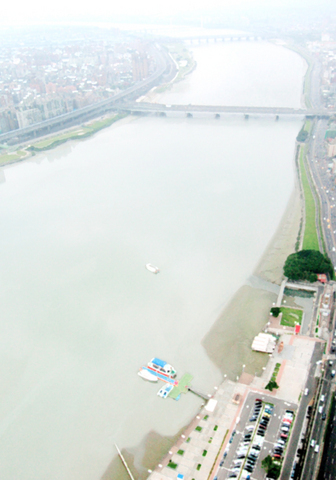
The main trunk of the River Cruise runs along the Danshui River, stretching from its northernmost point at Fisherman's Wharf in Danshui town to its southernmost point at Dadaocheng Wharf (大稻埕碼頭).
The other outpost of the River Cruise connects to the route along the Keelung River to Dajia Wharf (
Ferry rides between wharfs range in price from NT$20 to NT$250 depending on the distance traveled and the time of day. Additionally, from Danshui's Fisherman's Wharf (
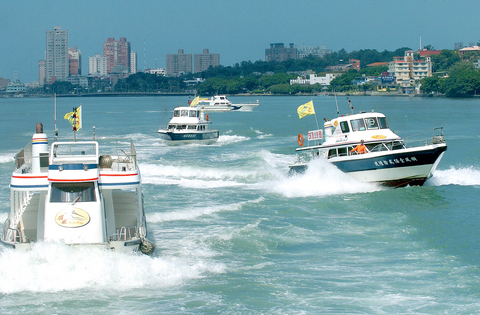
PHOTO: LIU HSIN-DE, TAIPEI TIMES
50-minute sightseeing cruise that takes passengers to the very mouth of the river. Most of the stop-off points connect to cycle ways that line the rivers and bikes can be rented nearby.
Getting started on any one of these routes is relatively easy as most of the wharfs are within walking distance of an MRT station or bus stop. On exiting Danshui MRT station, signs direct passengers to the wharf.
The town's waterfront and Old Street areas offer plenty of distractions for people of all ages, with arcades, stores selling traditional wares, and restaurants and small eateries that feature local specialties such as fish ball soup and steamed crabs and scallops.
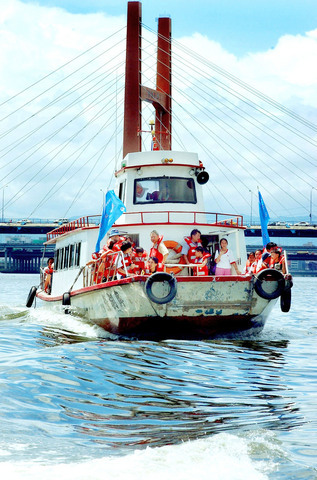
PHOTO: CHEN JUNG-FONG, TAIPEI TIMES
From Danshui Wharf, it is only a 10-minute ferry ride to nearby Fisherman's Wharf and Bali Wharf (八里碼頭). At Fisher-man's Wharf, take a leisurely walk across Lover's Bridge (情人橋) to arrive at the Fish Market, which is filled with vendors eager to let you sample their specialty foods, including sour plum juice and pork jerky. Live fish can be bought from the market's many tanks. The restaurant one floor above will cook fish bought from the market below.
Tourist spots include the Shihsanhang Museum of Archeology (
These three areas surrounding the wharfs on the Blue Highway routes are delightful in their lack of city buzz. The air is refreshing, and the scenery, especially the views of the river and Guanyin Mountain, are quiet reminders of Taiwan's natural beauty.
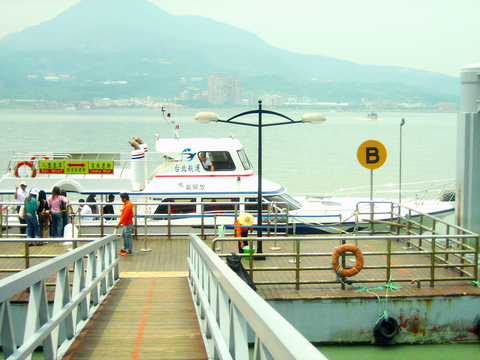
PHOTO: MEAGAN HU, TAIPEI TIMES
The boat ride from Bali or Danshui to Guandu Wharf (
Riding the ferry to Dadaocheng takes you away from the calm of Danshui back into the metropolitan bustle of Taipei. And while the ferry ride is enjoyable along this stretch of the Blue Highway, the inherent charm of this River Cruise is the respite from the city smog that it offers, something that is most noticeable along the Danshui leg of the route.
Dadaocheng Wharf has many points of interest, including the Lin Liu-Hsin Puppet Museum (林柳新紀念偶戲博物館) and Hsiahai City God Temple (霞海城隍廟), located on the well-preserved Dihua Street (迪化街).
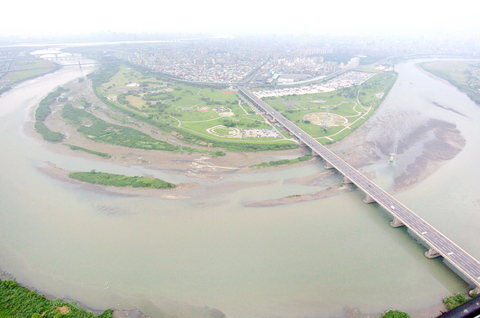
PHOTO: CHAO SHIH-HSUN
It is also possible to take the ferry along Keelung River to the Dajia Wharf.
Here, you can visit Taipei Fine Arts Museum (台北市立美術管館) the Taipei Children's Recreation Center (台北兒童育樂中心), or the nearby amusement park. Perhaps the most scenic areas Dajia Wharf has to offer are the Dajia Riverside Park (大佳河濱公園), which boasts a grand water fountain, as well as the expansive Xinsheng Park (新生公園), which is a great place for group outings and sporting activities.
There are different types of passenger boats to choose from along the Blue Highway, operated by different companies. The 80-seat ferries that ply the route sell snacks and beverages and have plenty of room to enjoy the outdoor surroundings. The seating on the smaller speedboats is enclosed, giving only a limited view of the riverbanks, and the ride tends to be uncomfortably loud and bumpy.
The Blue Highway can be unreliable. On a recent trip this reporter found that ferries were not running from Guandu Wharf, meaning that buses and MRT transportation were required to travel to and from this spot. It's easy enough to do, but certainly a letdown if your aim is to get out on the water.
However, these temporary incon-veniences are to be expected as the Taipei City Government is working to improve the Blue Highway system. Just recently, the Public Works Department spent NT$175 million on constructing new marinas for ferries at the Dajia Wharf. Further improvements the city has in mind include the use of solar-powered boats.
Despite some shortcomings, the Blue Highway is a relatively cheap and convenient way to taste local specialties, take in a number of interesting tourist spots and enjoy the open spaces that the river offers.

One of the biggest sore spots in Taiwan’s historical friendship with the US came in 1979 when US president Jimmy Carter broke off formal diplomatic relations with Taiwan’s Republic of China (ROC) government so that the US could establish relations with the People’s Republic of China (PRC). Taiwan’s derecognition came purely at China’s insistence, and the US took the deal. Retired American diplomat John Tkacik, who for almost decade surrounding that schism, from 1974 to 1982, worked in embassies in Taipei and Beijing and at the Taiwan Desk in Washington DC, recently argued in the Taipei Times that “President Carter’s derecognition

This year will go down in the history books. Taiwan faces enormous turmoil and uncertainty in the coming months. Which political parties are in a good position to handle big changes? All of the main parties are beset with challenges. Taking stock, this column examined the Taiwan People’s Party (TPP) (“Huang Kuo-chang’s choking the life out of the TPP,” May 28, page 12), the Democratic Progressive Party (DPP) (“Challenges amid choppy waters for the DPP,” June 14, page 12) and the Chinese Nationalist Party (KMT) (“KMT struggles to seize opportunities as ‘interesting times’ loom,” June 20, page 11). Times like these can

JUNE 30 to JULY 6 After being routed by the Japanese in the bloody battle of Baguashan (八卦山), Hsu Hsiang (徐驤) and a handful of surviving Hakka fighters sped toward Tainan. There, he would meet with Liu Yung-fu (劉永福), leader of the Black Flag Army who had assumed control of the resisting Republic of Formosa after its president and vice-president fled to China. Hsu, who had been fighting non-stop for over two months from Taoyuan to Changhua, was reportedly injured and exhausted. As the story goes, Liu advised that Hsu take shelter in China to recover and regroup, but Hsu steadfastly

You can tell a lot about a generation from the contents of their cool box: nowadays the barbecue ice bucket is likely to be filled with hard seltzers, non-alcoholic beers and fluorescent BuzzBallz — a particular favorite among Gen Z. Two decades ago, it was WKD, Bacardi Breezers and the odd Smirnoff Ice bobbing in a puddle of melted ice. And while nostalgia may have brought back some alcopops, the new wave of ready-to-drink (RTD) options look and taste noticeably different. It is not just the drinks that have changed, but drinking habits too, driven in part by more health-conscious consumers and